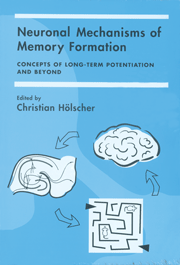Book contents
- Frontmatter
- Contents
- Contributors
- Introduction: Long-Term Potentiation as a Model for Memory Mechanisms: The Story So Far
- Section One Long-Term Potentiation In Vitro and In Vivo: How Can We Fine-Tune the Current Models for Memory Formation?
- Section Two There is More to the Picture Than Long-Term Potentiation: Theta or Gamma Oscillations in the Brain and the Facilitation of Synaptic Plasticity
- Section Three Making Models from Empirical Data of Synaptic Plasticity
- Section Four Setting the Stage for Memory Formation: Stress, Arousal, and Attention
- Section Five Transgenic Mice as Tools to Unravel the Mechanisms of Memory Formation
- 17 In Vivo Recording of Single Hippocampal Place Cells in Behaving Transgenic Mice
- 18 Understanding Synaptic Plasticity and Learning through Genetically Modified Animals
- 19 What Gene Activation Can Tell Us about Synoptic Plasticity and the Mechanisms Underlying the Encoding of the Memory Trace
- Conclusions and Future Targets
- Index
17 - In Vivo Recording of Single Hippocampal Place Cells in Behaving Transgenic Mice
Published online by Cambridge University Press: 13 October 2009
- Frontmatter
- Contents
- Contributors
- Introduction: Long-Term Potentiation as a Model for Memory Mechanisms: The Story So Far
- Section One Long-Term Potentiation In Vitro and In Vivo: How Can We Fine-Tune the Current Models for Memory Formation?
- Section Two There is More to the Picture Than Long-Term Potentiation: Theta or Gamma Oscillations in the Brain and the Facilitation of Synaptic Plasticity
- Section Three Making Models from Empirical Data of Synaptic Plasticity
- Section Four Setting the Stage for Memory Formation: Stress, Arousal, and Attention
- Section Five Transgenic Mice as Tools to Unravel the Mechanisms of Memory Formation
- 17 In Vivo Recording of Single Hippocampal Place Cells in Behaving Transgenic Mice
- 18 Understanding Synaptic Plasticity and Learning through Genetically Modified Animals
- 19 What Gene Activation Can Tell Us about Synoptic Plasticity and the Mechanisms Underlying the Encoding of the Memory Trace
- Conclusions and Future Targets
- Index
Summary
SUMMARY
In order to draw a closer connection between spatial memory and hippocampal long-term potentiation (LTP), the activity of a place cell that fires selectively when an animal is located in a certain area of a maze was examined in freely behaving knock-out mice that exhibit spatial learning deficit and altered hippocampal plasticity. This approach seeks to examine the effects of altered synaptic plasticity on the information coding mechanism by characterizing firing properties of certain hippocampal neurons directly underlying perception and memory. Available recording data indicated that synaptic plasticity in the hippocampus is not an essential mechanism for the formation of place selective firing of hippocampal pyramidal neurons, but is important for fine tuning and stabilizing its neural activity across time.
Together with genetic, pharmacologic, and in vitro electrophysiologic studies, this type of approach should allow us to examine whether experimental manipulations that block LTP change the capacity of neurons to process critical sensory stimuli and to code relevant cues into memory, and thus should provide a unique and promising avenue in bringing further insight into the cellular and physiologic mechanisms underlying learning and memory.
Introduction
A major focus of neuroscience research, and the central topic of this volume, is the identification of cellular and molecular plasticity mechanisms that mediate memory. Most studies aimed at this goal involve attempts to relate physiologic or molecular indices of neural plasticity to behavioral performance in learning and memory tests.
- Type
- Chapter
- Information
- Neuronal Mechanisms of Memory FormationConcepts of Long-term Potentiation and Beyond, pp. 407 - 426Publisher: Cambridge University PressPrint publication year: 2000



